Just in case you didn't know it's on the 21st / 22nd of September...
It's going to be one hell of a premiere!! www.ageofstupid.net
PS. Sorry about the silence, lots of things going on. I'll be back soon...
Weekly (weekly)
5 years ago
 I can’t wait to get Wheeler’s ice cream over here, but at least in the meantime they have produced a recipe book, The Vegan Scoop. Yay!
I can’t wait to get Wheeler’s ice cream over here, but at least in the meantime they have produced a recipe book, The Vegan Scoop. Yay! Update
Update This year seems to be a year for brilliant independent films. Watching “A delicate balance” by Aaron Scheibner was a life-changing event for me.
This year seems to be a year for brilliant independent films. Watching “A delicate balance” by Aaron Scheibner was a life-changing event for me. You’ll probably recognise the Seeds of Change brand, they’ve been in the UK since the late 1990’s with their organic sauces and soups (amongst other things). It was the American branch though that sent me the chocolate.
You’ll probably recognise the Seeds of Change brand, they’ve been in the UK since the late 1990’s with their organic sauces and soups (amongst other things). It was the American branch though that sent me the chocolate. Now, on to the flavours; from left to right,
Now, on to the flavours; from left to right,  We went “ooooh”, when we opened up the first packet. The chocolate is split into three individually packaged mini bars. Wrapped in plastic though, plastic?! Needless to say, I’d have preferred paper. B thought the three bar idea might help her willpower and resolve not to eat the whole pack in one go!
We went “ooooh”, when we opened up the first packet. The chocolate is split into three individually packaged mini bars. Wrapped in plastic though, plastic?! Needless to say, I’d have preferred paper. B thought the three bar idea might help her willpower and resolve not to eat the whole pack in one go!
 The answer hit me when I found out that my workplace was going to bin a load of lever arch files. The files were old and the lever arch mechanisms had failed, you know the way they do when the metal pins that goes through the paper holes no longer match up, very annoying. But I didn't need the metal bit, just the file cases. My lucky day.
The answer hit me when I found out that my workplace was going to bin a load of lever arch files. The files were old and the lever arch mechanisms had failed, you know the way they do when the metal pins that goes through the paper holes no longer match up, very annoying. But I didn't need the metal bit, just the file cases. My lucky day. After I had drilled out the rivets holding the metal mechanism to the board casing the rest was really easy. I wound string around the spine so the middle page of each magazine could be secured into place. Each lever arch file holds approximately 15 magazines. In no time at all, I will have my surfaces back. Hooray!
After I had drilled out the rivets holding the metal mechanism to the board casing the rest was really easy. I wound string around the spine so the middle page of each magazine could be secured into place. Each lever arch file holds approximately 15 magazines. In no time at all, I will have my surfaces back. Hooray!
 If you are in the UK and are thinking about getting photovoltaic solar panels, then a quick step over to Friends of the Earth could pay off, quite literally! They are working on a "We Support Solar" campaign to get feed-in tariffs (ie pay households for any excess electricity their PV panels produce) set at a good rate. A few clicks and you can let your MP know that you'd like them to support the idea. Or you can find out if your MP has already signed EDM 680: Solar Energy first and thank them!!
If you are in the UK and are thinking about getting photovoltaic solar panels, then a quick step over to Friends of the Earth could pay off, quite literally! They are working on a "We Support Solar" campaign to get feed-in tariffs (ie pay households for any excess electricity their PV panels produce) set at a good rate. A few clicks and you can let your MP know that you'd like them to support the idea. Or you can find out if your MP has already signed EDM 680: Solar Energy first and thank them!!
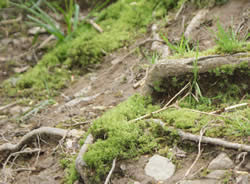 There was a bit of a duck population explosion a few years ago (from three to 10 or so ducks) at Chris Dixon's. The increase in duck feet meant that the soil on their regular route down to the pool had been eroded and the tree roots steadily exposed. On top of this, the change in weather patterns over the recent years has increased the occurrence of sudden downpours of rain. The huge quantities of water hurtle down the stream (raising the level of the water) and causes further damage to the banks.
There was a bit of a duck population explosion a few years ago (from three to 10 or so ducks) at Chris Dixon's. The increase in duck feet meant that the soil on their regular route down to the pool had been eroded and the tree roots steadily exposed. On top of this, the change in weather patterns over the recent years has increased the occurrence of sudden downpours of rain. The huge quantities of water hurtle down the stream (raising the level of the water) and causes further damage to the banks. All in all, the instability of banks had been playing on Chris’s mind. He had experimented with using bundles of long thin lengths of wood (he called them fascines) and laying the fascines on contour across the slopes so that any leaf litter, twigs etc would get caught behind and create steps/areas where plants could eventually grow. You can see Chris’s work on the left of the picture (the duck house is at the top of the slope). Our job was to add the fascines to the slope on the right (the fascines are already layed in place) and create steps for the ducks to take a different route down to the pool.
All in all, the instability of banks had been playing on Chris’s mind. He had experimented with using bundles of long thin lengths of wood (he called them fascines) and laying the fascines on contour across the slopes so that any leaf litter, twigs etc would get caught behind and create steps/areas where plants could eventually grow. You can see Chris’s work on the left of the picture (the duck house is at the top of the slope). Our job was to add the fascines to the slope on the right (the fascines are already layed in place) and create steps for the ducks to take a different route down to the pool.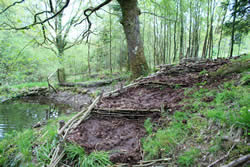 The next day we needed more wood and stakes to make the steps down to the pool and generally finish off. It was great to have the right kind of wood just growing on site (we took more from the willow used the day before). I wove the steps while Craig (Transition House) ferried well-rotted compost from another part of the garden to fill in the steps. The infilled steps covered the worst of the exposed roots.
The next day we needed more wood and stakes to make the steps down to the pool and generally finish off. It was great to have the right kind of wood just growing on site (we took more from the willow used the day before). I wove the steps while Craig (Transition House) ferried well-rotted compost from another part of the garden to fill in the steps. The infilled steps covered the worst of the exposed roots. Chris’s comfrey bed is next to his polytunnel, in the enclosed formal productive garden (by formal I suppose I mean more allotment style garden as opposed to food forest). The gates to this area are kept shut for most of the time (as far as I could tell), which meant that I couldn't be distracted too much by Mac (the dog) and Scamp (the lamb (that kind of thought she was a dog because she’d had been reared in the house)). It also meant that because Chris’s khaki campbell duck slug patrol unit do such a good job at eating slugs outside of this area, it’s worth scooping up any slugs found within the fencing and giving them to the ducks (I didn’t find any slugs).
Chris’s comfrey bed is next to his polytunnel, in the enclosed formal productive garden (by formal I suppose I mean more allotment style garden as opposed to food forest). The gates to this area are kept shut for most of the time (as far as I could tell), which meant that I couldn't be distracted too much by Mac (the dog) and Scamp (the lamb (that kind of thought she was a dog because she’d had been reared in the house)). It also meant that because Chris’s khaki campbell duck slug patrol unit do such a good job at eating slugs outside of this area, it’s worth scooping up any slugs found within the fencing and giving them to the ducks (I didn’t find any slugs). Job done.
Job done. We rented a small cottage for the week that had spectacular views across the Dyfi valley and a gorgeous bluebell wood just along the lane. First impressions were good, small glass and metal recycling boxes outside, paper and plastic recycling bins inside. Fantastic. Kettle on, cuppa, teabags, oh… What do I do with this then? I spent the next few minutes walking around while balancing a spent tea bag on a teaspoon, trying to find a compost bin. Bokashi bin in the cupboards? No. It had to go into the landfill bin. I have to say, that was a very odd experience. I can’t remember the last time I’d put compostable waste into bin destined for landfill (I managed to persuade the caretakers at work to give me space for the “team worms” – the wormery behind the bike shed – ages ago). It was surprising just how easily the small green changes at home and work had been incorporated into my life and that not recycling just felt alien and wrong.
We rented a small cottage for the week that had spectacular views across the Dyfi valley and a gorgeous bluebell wood just along the lane. First impressions were good, small glass and metal recycling boxes outside, paper and plastic recycling bins inside. Fantastic. Kettle on, cuppa, teabags, oh… What do I do with this then? I spent the next few minutes walking around while balancing a spent tea bag on a teaspoon, trying to find a compost bin. Bokashi bin in the cupboards? No. It had to go into the landfill bin. I have to say, that was a very odd experience. I can’t remember the last time I’d put compostable waste into bin destined for landfill (I managed to persuade the caretakers at work to give me space for the “team worms” – the wormery behind the bike shed – ages ago). It was surprising just how easily the small green changes at home and work had been incorporated into my life and that not recycling just felt alien and wrong.  I wasn't really sure that to do with the contents of the bins. I don't know if they will still have the same beneficial properties of properly made bokashi (probably not), or whether they are going to kill any plants that grow near it (I hope not!), so I decided to add one to our main compost bin (on the grounds that it's only half full and it will be diluted) and one to a flower bed.
I wasn't really sure that to do with the contents of the bins. I don't know if they will still have the same beneficial properties of properly made bokashi (probably not), or whether they are going to kill any plants that grow near it (I hope not!), so I decided to add one to our main compost bin (on the grounds that it's only half full and it will be diluted) and one to a flower bed.  I was given one of these rather super recycled tetra pack purses recently and need to know how it was made, so I took it apart.
I was given one of these rather super recycled tetra pack purses recently and need to know how it was made, so I took it apart.  1) You'll need some tetra pak cartons. For this purse I used the tall 1 litre type.
1) You'll need some tetra pak cartons. For this purse I used the tall 1 litre type. 3) Cut off the top and bottom.
3) Cut off the top and bottom.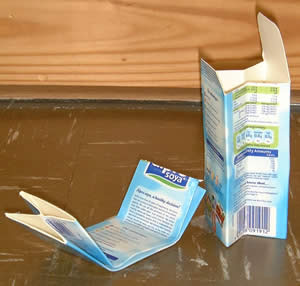 7) Fold the bottom of the carton towards the top, and the top towards the bottom, so that it has three (aproximately equal - but the top can be shorter) parts.
7) Fold the bottom of the carton towards the top, and the top towards the bottom, so that it has three (aproximately equal - but the top can be shorter) parts. 11) Cut the internal flap to about 1.5cm (half an inch) above the crease and diagonally cut from about 1cm along that edge to the nearest corner (on each side).
11) Cut the internal flap to about 1.5cm (half an inch) above the crease and diagonally cut from about 1cm along that edge to the nearest corner (on each side). 13) Put the shorter flap over and inside of the bottom compartment. You will need to secure this some how. I've used a paper clip in the photo because I couldn't find a darning needle to make some holes and sew the sections togther - that would be my preferred method, but you could glue the flap in place.
13) Put the shorter flap over and inside of the bottom compartment. You will need to secure this some how. I've used a paper clip in the photo because I couldn't find a darning needle to make some holes and sew the sections togther - that would be my preferred method, but you could glue the flap in place. 16) Loop the elastic band around the purse to secure the contents.
16) Loop the elastic band around the purse to secure the contents. Craig has a penchant for chillies so this year I'm growing him several different types (some have rather concerning names like "Ring of fire" and "Fatalii"). Anyway, that combined with my desire to have a bountiful vegetable garden means that I am rapidly running out of window ledges to start my seeds off on.
Craig has a penchant for chillies so this year I'm growing him several different types (some have rather concerning names like "Ring of fire" and "Fatalii"). Anyway, that combined with my desire to have a bountiful vegetable garden means that I am rapidly running out of window ledges to start my seeds off on. I've been meaning to watch the Story of Stuff for a long time now. I don't know why I didn't watch it earlier, just one of those things. It's a 20 minute long animated story of the mess our consumerism is getting us into written by Annie Leonard. Concise and nicely illustrated. Definately watch it if you have 20 mins spare, and encourage others to watch it too.
I've been meaning to watch the Story of Stuff for a long time now. I don't know why I didn't watch it earlier, just one of those things. It's a 20 minute long animated story of the mess our consumerism is getting us into written by Annie Leonard. Concise and nicely illustrated. Definately watch it if you have 20 mins spare, and encourage others to watch it too.
 There are only a few things that are guaranteed to get me dancing around the kitchen on a Saturday morning like a whirling, jumping loon. This was one of those moments.
There are only a few things that are guaranteed to get me dancing around the kitchen on a Saturday morning like a whirling, jumping loon. This was one of those moments.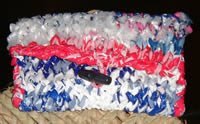 A quick update about the plarn knitting experiment (hate plastic, love plarn post). A friend gave me a load of plastic bags that were nearing their re-use (as a plastic bag) life, so I was able to get on and start knitting with plarn.
A quick update about the plarn knitting experiment (hate plastic, love plarn post). A friend gave me a load of plastic bags that were nearing their re-use (as a plastic bag) life, so I was able to get on and start knitting with plarn.  Don't you just hate those people that when ever you try to talk to them about climate change or sustainability, they are totally convinced that what ever they do, somehow their actions don't count?
Don't you just hate those people that when ever you try to talk to them about climate change or sustainability, they are totally convinced that what ever they do, somehow their actions don't count? May I accept this rubbish award for Rubbish Newcomer on behalf of the Transition House and this blog.
May I accept this rubbish award for Rubbish Newcomer on behalf of the Transition House and this blog.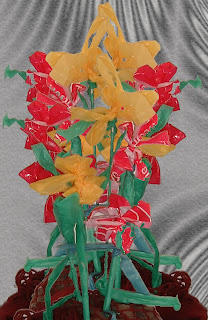 This bouquet was made, at great expense (to the housework), but you will be pleased to hear that not a single heated greenhouse was used or air mile flown to get these flowers to you today. All the items can be re-used, if you so wish, the stalks are plastic bag wrapped knitting needles and the flowers strips of plastic yarn (plarn). Oh, and a little photo jiggery-pokery. Well, plastic bags are so difficult to find these days!
This bouquet was made, at great expense (to the housework), but you will be pleased to hear that not a single heated greenhouse was used or air mile flown to get these flowers to you today. All the items can be re-used, if you so wish, the stalks are plastic bag wrapped knitting needles and the flowers strips of plastic yarn (plarn). Oh, and a little photo jiggery-pokery. Well, plastic bags are so difficult to find these days! The evening ended back in Cambridge where Rosemay Randall (Cambridge Carbon Footprint) and Tony Juniper (FOI director for 8 years) gave a couple of excellent speeches. Then Craig (Transition House) persuaded me that I needed to have my photo taken with Tony for this blog so here we are! (and yes I am wearing a dress!! well it was a premiere).
The evening ended back in Cambridge where Rosemay Randall (Cambridge Carbon Footprint) and Tony Juniper (FOI director for 8 years) gave a couple of excellent speeches. Then Craig (Transition House) persuaded me that I needed to have my photo taken with Tony for this blog so here we are! (and yes I am wearing a dress!! well it was a premiere).
 I've made my first guerilla bag!! I know I should give it away, but I'm going to keep it. I figure it gets the message out whoever is carrying it. Plus I haven't sewn with a sewing machine in ages, so the stitching is a little wonky and I think, actually, I've sewn the wrong three sides together - I'll call it a "practice" bag.
I've made my first guerilla bag!! I know I should give it away, but I'm going to keep it. I figure it gets the message out whoever is carrying it. Plus I haven't sewn with a sewing machine in ages, so the stitching is a little wonky and I think, actually, I've sewn the wrong three sides together - I'll call it a "practice" bag. Step one
Step one Towards the end of the sorting process my mind usually flits to a book I read as a child, The Twits by Roald Dahl. The worms have so little space to hide from the sun that they mass together in a wiggling, wriggling worm spaghetti.
Towards the end of the sorting process my mind usually flits to a book I read as a child, The Twits by Roald Dahl. The worms have so little space to hide from the sun that they mass together in a wiggling, wriggling worm spaghetti. I have never worked with green wood before, it was so much fun and, unlike working with seasoned wood, it was peaceful, gentle and not dry!! I'll explain (Skip this paragraph if you know about green wood!!). Green wood is wood from trees that has recently been felled. It has not been dried (seasoned) and so it still wet. because it is still "green" we could work on it with tools and machines that didn't need any electricity. The process of making things out of the wood didn't dry our hands, it didn't create dust (so no need for face masks and goggles) and there was very little chance of getting splinters. What's more, because no heavy machinery was involved, we could hold conversations whilst getting on with the work. I say "work", - we made a load of useful things.
I have never worked with green wood before, it was so much fun and, unlike working with seasoned wood, it was peaceful, gentle and not dry!! I'll explain (Skip this paragraph if you know about green wood!!). Green wood is wood from trees that has recently been felled. It has not been dried (seasoned) and so it still wet. because it is still "green" we could work on it with tools and machines that didn't need any electricity. The process of making things out of the wood didn't dry our hands, it didn't create dust (so no need for face masks and goggles) and there was very little chance of getting splinters. What's more, because no heavy machinery was involved, we could hold conversations whilst getting on with the work. I say "work", - we made a load of useful things. Under the expert and skilled guidance of Mike, we made a fabulous stool, froe handle, club, maul (huge great club for whacking onto axes into logs), and a shaving horse. We both got to have a go at using a load of different tools including (my favourite) a pole lathe.
Under the expert and skilled guidance of Mike, we made a fabulous stool, froe handle, club, maul (huge great club for whacking onto axes into logs), and a shaving horse. We both got to have a go at using a load of different tools including (my favourite) a pole lathe. Probably the most impressive thing about the whole green woodworking malarky for me was Mike's technique for joining the mortice and tenon joints in the stool. Basically it all revolved around the fact that the wood will dry as times goes by. Therefore you have to make allowances for the shrinkage. If the mortice (hole) is made slightly smaller than the tenon, the tenon should never come loose. Certainly, when we had cramped one side of the stool together my husband was able to hang from it and the joints didn't budge one millimetre.
Probably the most impressive thing about the whole green woodworking malarky for me was Mike's technique for joining the mortice and tenon joints in the stool. Basically it all revolved around the fact that the wood will dry as times goes by. Therefore you have to make allowances for the shrinkage. If the mortice (hole) is made slightly smaller than the tenon, the tenon should never come loose. Certainly, when we had cramped one side of the stool together my husband was able to hang from it and the joints didn't budge one millimetre. For more information about transition towns see The Transition Handbook (I'm on page 61) or the Transition Towns wiki.
For more information about transition towns see The Transition Handbook (I'm on page 61) or the Transition Towns wiki.



The thing is, I love these kind of books.
Was my husband coming around to my way of thinking? Will I be able to store bits of old "junk" on the off-chance that it will be useful at some point without having to go through that dreaded "clear out"? Will he no-longer complain about the smell of clothes from second-hand shops? Only time will tell.
On a more serious note, this is a year long experiment to see how much we can reduce our footprint on the planet. It's going to be fun.
If the charts aren't working (or you want a closer look) you can see them on the ReadYourMeter website, just pick "Transition House" from the drop down menu.